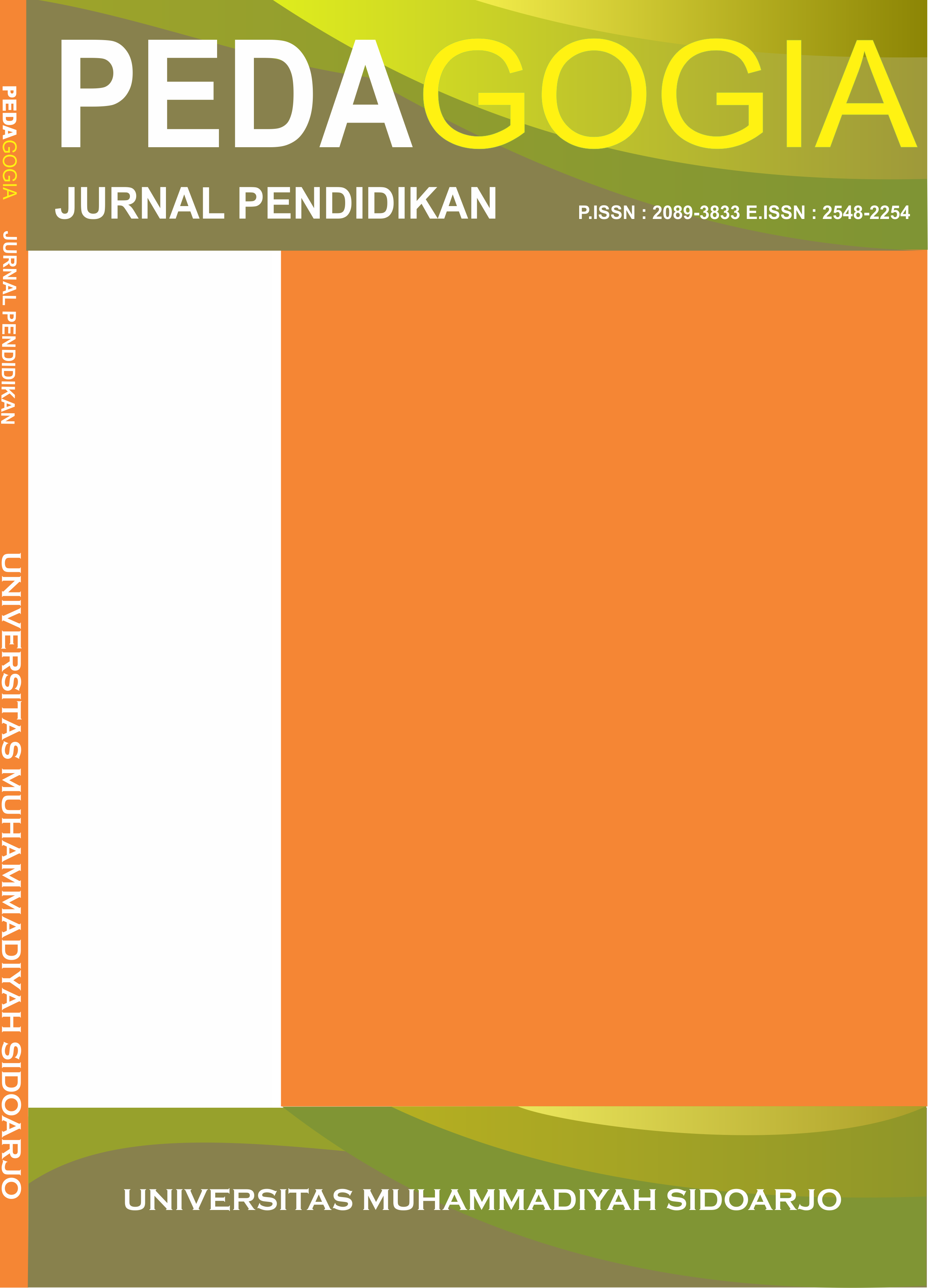VARK (Visual, Auditory, Read/Write and Kinesthetics) Model with Digital Scrapbook for Improving Al-Quran Reading Skills
DOI:
https://doi.org/10.21070/pedagogia.v14i2.1898Keywords:
Digital Scrapbook, Al-Quran, Reading SkillsAbstract
This study uses a research design adapted from Plomp (1997), which is considered a general model that is easy to apply in the development of learning models. The stages in this research include: (1) Initial investigation or preliminary study; (2) Design; (3) Realisation/Construction; (4) Expert validation test, pilot test, evaluation, and revision; and (5) Implementation. The main purpose of this research is to develop a learning model for primary school students, especially grade V students. The developed learning model refers to VARK (Visual, Auditory, Read/Write, and Kinesthetic) based on Digital Scrapbook. This model aims to familiarise students in reading the Qur'an well and improve their skills. This approach incorporates a variety of learning styles to support a thorough mastery of Qur'ānic reading skills. Digital Scrapbook-based VARK is designed to suit students' needs and facilitate variations in their ways of learning. This research is expected to produce an innovative learning model that is effective and easy to implement in the context of Islamic values-based basic education.
Highlights:
-
Improved Reading Ability: Students taught using the PQRST-STAD method with short videos performed better than those using picture series.
-
Method Effectiveness: Short videos enhance the effectiveness of integrated PQRST-STAD for reading narrative texts.
-
Future Recommendations: Further development is needed in designing creative and detailed video/image content for learning.
Keywords: Digital Scrapbook, Al-Quran, Reading Skills
References
Alhamuddin, A., Inten, D. N., Mulyani, D., & Erlangga, R. D. (2022). 21st century learning. In 4th Social and Humanities Research Symposium (SoRes 2021) (pp. 332-337). Atlantis Press.
Beltran, K., Abonita, A., Brazal, A., Relente, J., & Relente, J. M. (2025). Visual, Auditory, Read/Write and Kinesthetic (VARK) Model-Based Peer Teaching Approach. Educative: Jurnal Ilmiah Pendidikan, 3(1), 17-24.
Dutsinma, L. I. F., & Temdee, P. (2020). VARK Learning Style Classification Using Decision Tree with Physiological Signals. Wireless Personal Communications , 115 (4), 2875 – 2896. https://doi.org/10.1007/s11277-020-07196-3
Firmansyah, F., Ali, M., & Romli, R. (2022). Pelatihan Membaca Al-Quran dengan Metode Tahsin Tilawah untuk Meningkatkan Kualitas Bacaan Bagi Siswa SMA Muhammadiyah 1 Palembang. Dimas: Jurnal Pemikiran Agama Untuk Pemberdayaan, 22(1), 133–148. https://doi.org/10.21580/dms.2022.221.10844
Herlita, A. (2025). The Effect Of Vark (Visual Auditory Read/Write Kinesthetic) Strategy Toward Students’ Reading Comprehension (A Quasi Experimental at Second Grade Students' of SMAN 3 Kota Bengkulu). Jurnal Kajian Ilmu Pendidikan (JKIP), 6(1), 47-62.
Hidayah, S., & Zumrotun, E. (2023). Penggunaan Metode Qiro’ati Dalam Pembelajaran Membaca Al-Quran Di Sekolah Dasar. Attadrib: Jurnal Pendidikan Guru Madrasah Ibtidaiyah, 6(2), 353-364.
Kurniasih MD, et al. (2022). Development of a Mini Guidebook for Independent Research Based on 4C Skills for Plant Reproduction and Embryology Courses. Journal of Biology and Science Education , 5 (1), 255–266.
Kemdikbudristekdikti. (2022). Guide to Developing Projects for Strengthening Digital technology Student Profiles. Kemdikbudristekdikti.
Moran, C., and L. Van Leent. (2022). “Primary School Parents’ Perspectives on Relationships and Sexuality Education in Queensland, Australia.” Sex Education 22 (2): 184–197. https://doi.org/10.
/14681811.2021.1908982
Oliva - Cordova, L. M., Garcia- Cabot, A., & Amado - Salvatierra, H. R. (2021). Learning Analytics to Support Teaching Skills: A Systematic Literature Review. IEEE Access,9, 58351 –58363. https://doi.org/10.1109/ACCESS.2021.3070294
Plomp, T. (1997). Educational and Training Systems Design: Introduction. Enschede: University of Twente, Faculty of Educational Science and Technology Enschede
Septia, S., Rudini, R., & Mahatma, M. (2023). Pembentukan Karakter Peserta Didik Melalui Pelajaran Pendidikan Al-Islam dan Kemuhammadiyahan di SDMuhammadiyah Toboali.LENTERNAL: Learning and Teaching Journal,4(2), 95–100.https://doi.org/10.32923/lenternal.v4i2.3693
Sugiyono. (2011). Combination Research Methods (mixed methods) . Alphabet.
Sugiyono. (2013). Quantitative, qualitative and R & D (Reasearch and Development) research methods. Alphabet.
Syahrum, T. B. S, & Purnamasari, H. (2021). Penggunaan Media PembelajarannScrapbook Untuk Meningkatkan Keterampilan Menulis dan Keterampilan Berbicara. Indonesian Journal of Instructional Technology, 2 (2), 53-61.
Sholikha, SN, & Fitrayati, D. (2021). Integration of 4C Skills in SMA/MA Economics Textbooks. Educative: Journal of Educational Sciences , 3 (5), 2402–2418. https://edukatif.org/index.php/edukatif/article/view/823
Susandi, A., Amelia, D. J. ., Huda, M. M., MZ, A. S. A., & Khasanah, L. A. I. U. . (2025). Relevansi Kurikulum Merdeka Berbasis Literasi Digital Menuju Generasi Indonesia Emas 2045. Journal of Nusantara Education, 4(2), 107–117. https://doi.org/10.57176/jn.v4i2.148
Tabroni, I., Sari, RP, Jamil, NA, & Irpani, A. (2022). Development of a Character Education Model for Children in Lebak Kinasih Housing, Purwakarta Regency. Islamic Education: Journal of Islamic Education , 11 (03), 1013. https://doi.org/10.30868/ei.v11i03.3159
Ullman, J. (2022). “Trans/gender-Diverse Students’ Perceptions of Positive School Climate and Teacher Concern As Factors in School Belonging: Results from an Australian National Study.” Teachers College Record 124 (8): 145–167. https://doi.org/10.1177/01614681221121710
Weganofa, R., Liskinasih, A., Herawati, S., & Rustiani, I. (2022). An analysis of Fleming’s theory on Vark (visual, aural, read/write, and kinesthetic) learning style in college students. J Ilmiah Bahasa Sastra, 9, 40-53.
Downloads
Published
How to Cite
Issue
Section
License
Authors retain copyright and grant the journal right of first publication with the work simultaneously licensed under a Creative Commons Attribution 4.0 International License that allows others to share the work with an acknowledgement of the work's authorship and initial publication in this journal.








